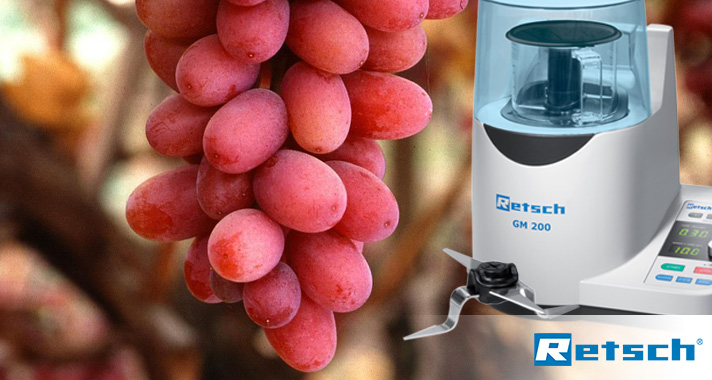The grape anthocyanin assay (Iland) is dependent upon sample protocol and homogeneity. Whole berries (200 g) are hand selected and homogenised in the Grindomix GM 200 and a measured quantity of the grape homogenate is extracted for anthocyanin in an alcoholic acidic solution.
The colour in red grapes and wine provides an indication of quality with respect to wine scoring.
Studies in conjunction with the Australian Wine Research Institute in Adelaide, South Australia*, have demonstrated that the measurement of color in red grapes and wine can provide an indication of quality with respect to wine scoring (Somers). Thus the measurement of grape anthocyanins (color) is currently being pursued to assess the quality of red grapes in warm grape growing regions.
The grape anthocyanin assay (Iland) is dependent upon sample protocol and homogeneity. Whole berries (200 g) are hand selected and homogenised in the Grindomix GM 200 and a measured quantity of the grape homogenate is extracted for anthocyanin in an alcoholic acidic solution.
The extraction of anthocyanins into an acidic, ethanol solution assumes that total ionisation of anthocyanins at low pH is achieved. The color (red) of ionised anthocyanins can be measured at 520 nm and as a result, total anthocyanins irrespective of grape pH can be calculated as malvidin equivalents.
A rapid technique has been developed using Near Infrared Spectroscopy (NIRS) for measuring a range of parameters including anthocyanins in grape homogenates (Gishen). This technique is based upon a calibration that is developed between the intensity of absorbance in the NIR spectrum (400 – 2500 nm) and analytical results determined by the assay previously described.
Grape homogenate samples are scanned and a result is generated from the calibration equation. This process is efficient, accurate and rapid.
[quote align=”left”]References
Somers, T.C; Evans, M.E. (1974) Wine Quality: correlations with colour density and anthocyanin equilibria in a group of young red wine. J. Sci. Food Agric. 1369 – 1379. Iland, P.G. (1987) Predicting red wine colour from grape analysis. Aust. Grape Grower & Winemaker, September. Gishen, M; Dambergs, R.G. (1998) Some preliminary trial in the application of scanning near infrared spectroscopy (NIRS) for determining the compositional quality of grape, wine and spirits. Aust. Grapegrower Winemaker, Annual Technical Issue, 47: 43 – 45.
[/quote]









